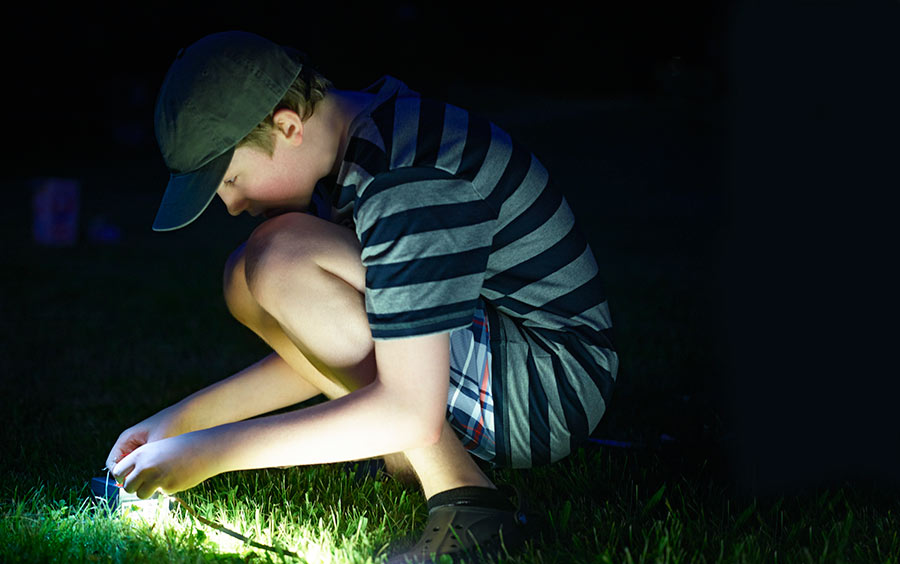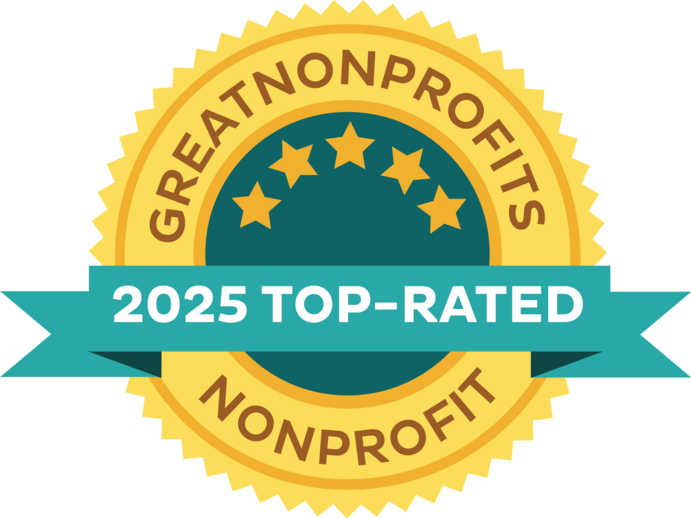Camper Mack Adams sets up skin-safe LED lights to illuminate the evening's outdoor activities.
By Deborah S. Sarnoff, MD, and Danielle Gerome
Photographs by Elisabeth Bernstein
When the sun starts to set, the countdown begins. The children excitedly check an ultraviolet (UV) light meter, waiting for it to register zero. Once the last rays of daylight have faded, they burst through the doors of the camp building into the great outdoors. Under a glowing moon, they play tag and soccer on a grassy field, splash in the lake or ride horses, experiencing the bliss of summer camp that many other kids take for granted.
Located on 60 acres in Craryville in upstate New York, Camp Sundown is a ‘night camp” designed for children with UV light-sensitivity disorders who must spend their lives shielded from daylight. Each year, the camp runs for two to six weeks, depending on funding, and draws children and their families from around the world. For these kids, it’s thrilling to be surrounded by peers who have also spent their lives experiencing the sun as a relentless enemy.
Kindred Spirits
Mackinly “Mack” Adams, 15, and his parents are among a core group of eight families who return to the camp every summer for one week. (Other weeks, the camp hosts new campers.) Mack has actinic prurigo, or AP, a condition that causes his skin to break out in severe rashes when exposed to UV light. He reacts even to fluorescent lights, which also emit UV, so he can’t go to school. Instead, he participates in an online home-schooling program in collaboration with his school district in Pittsburgh.
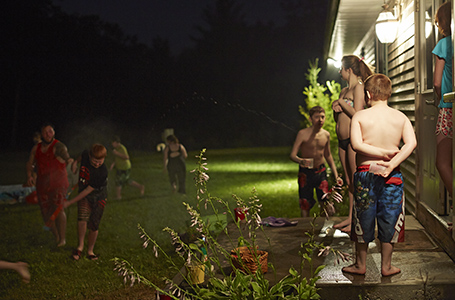
Let the Games Begin! When darkness falls, the kids can’t wait to compete in special water games organized by the camp and parents.
Like many of his peers with light-sensitivity disorders, Mack has to suit up in protective gear including sunglasses, a face visor, long sleeves, pants and gloves before going out in daylight. That can be daunting. “Most people would never think of making an offensive comment about a person in a wheelchair,” says Mack’s mom, Kelly Mellon Adams. “Yet some feel it’s OK to stare, point and laugh at these kids and make mean comments about how they’re dressed. It’s heartbreaking.”
But at Camp Sundown each summer, the kids feel like they belong. “It’s amazing, because we don’t need to explain what we have,” said Mack. “The first year we became best friends, and I look forward to seeing everyone.”
Where Kids Can Just Be Kids
Dan and Caren Mahar founded Camp Sundown in 1996 so that their daughter Katie, now 23, could experience summer camp like any other kid. At 2, Katie had been diagnosed with xeroderma pigmentosum (XP), a rare genetic disease that makes skin and eyes dangerously sensitive to UV light. Even just a few minutes in the sun can cause sunburn and blisters in people with this condition. Many patients with XP die young from skin cancer. Since her diagnosis as a toddler, Katie has not had any sun exposure. She is one of the oldest people with XP who has never had melanoma.
Camp Sundown is a “night camp” designed for children with UV light-sensitivity disorders who must spend their lives shielded from daylight.”
The camp started small, with only 11 families coming together for a five-day event at a local motel. The families all had a child with XP or another rare skin disease such as solar urticaria, porphyria, vitiligo or albinism that prevented them from going in the sun.
In 2003, through fund-raising efforts led by the Mahars, the current Camp Sundown was built on wooded land in Craryville. The building has eight bedrooms, each with two beds and a private bathroom. The rooms have tinted windows and light-blocking curtains. The camp uses incandescent (non-UV) bulbs with a maximum of 40 watts.
During the day, the children sleep part of the time. They eat together in a large dining hall and watch movies and play video games in an entertainment room. They can also swim indoors. While most indoor pools have windows that bathe the pool area in sunlight, the Mahars had the camp’s pool windows protected with 100 percent UV-blocking film, so that the kids could play and swim day or night.
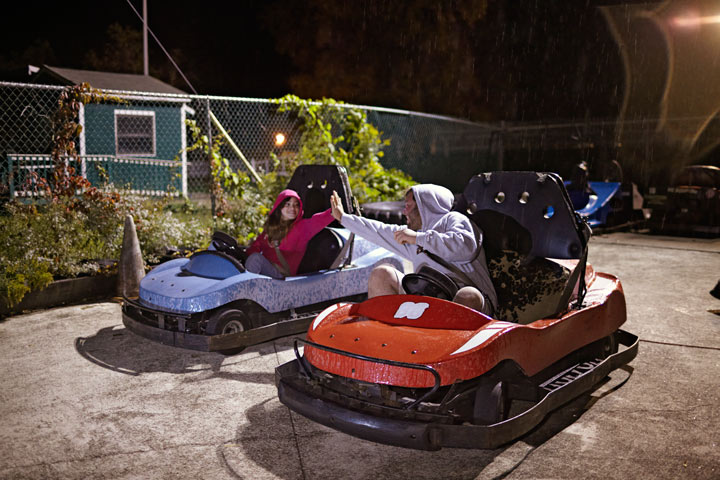
Former camper turned counselor Cristofeer Soto high-fives his sister before the start of a go-cart race field trip.
Nighttime is when the fun really begins. “I just feel more alive and active at night,” says Mack. With help from local businesses and organizations, there are planned nighttime activities such as art projects and field trips. Every year the kids have an evening outing at a nearby lake where they swim in the moonlight, ride horses and sing songs around a campfire.
A highlight of the summer is a field trip to the town of Campbell Hall, where its residents throw a moonlight festival for the campers. In past years this has included fireworks, hot-air balloon rides and carnival games. The children challenge the local fire department to an annual softball game that starts at 1 AM. They often don’t make it back to Camp Sundown until 5 AM. “The firemen mean so much to the kids,” says Kelly. “They look forward to Campbell Hall as much as Christmas.”
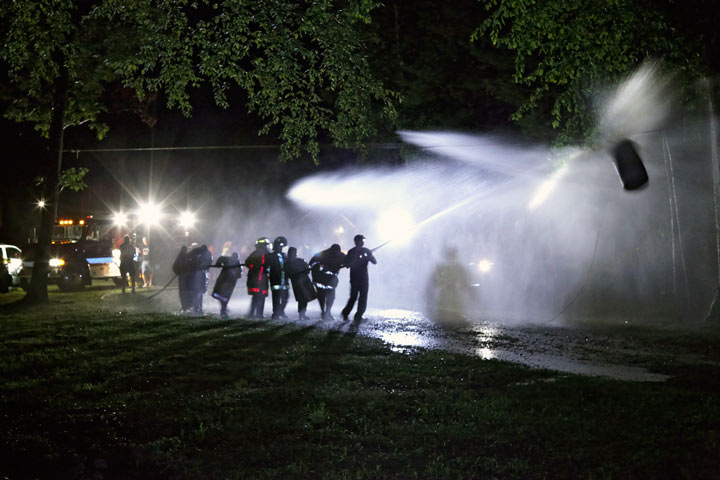
Local firefighters bring their trucks and gear so campers can compete to move the hanging object in the direction of the opposing team using the firehose.
Parent-to-Parent
Parents enjoy the week as a chance to swap advice and support other parents who have kids with light-sensitivity diseases. “We have some much-needed adult time, where we don’t have to worry about the kids,” says Kelly. The parents share tips on everything from the newest UV-protective clothing to medical research. They keep in touch during the year on a “Moonlight Mommas” Facebook group.
Camp Sundown turns night into day, giving children with life-threatening sun sensitivity fun under the stars.”
“I cannot begin to describe how much these families mean to me,” says Kelly. “Whenever a child has a bad day, we know that we can message, text, call or email and have the support we need. Camp Sundown may be one week a year, but its effects are felt every day. It means so much just knowing you’re not alone and that there is always someone a phone call away.”
“The biggest thing we help one another remember is that these are regular kids, just with an irregular schedule or irregular clothes,” adds Kelly.
Acceptance and Inspiration
Cristofeer Soto of Queens, New York, who has XP, started attending Camp Sundown in 2001 and now serves as a counselor. “I’ve met so many people from around the world who have become my family through the years,” he says. Cristofeer has endured a particularly challenging battle with the disease. Since the age of 4 he’s had 182 skin cancer surgeries, and his body is covered in brown spots.
As a role model for the kids, he teaches them to become more comfortable in their own skin. He tells them: “I’ve been bullied and called names because of the way I covered up to protect myself from the sun. Every day people are going to look at you. Their comments might be the worst, but that can be your motivation. You can’t let people get to you. Everyone is unique. You should be proud about who you are as a person and not worry about how you look. Keep your head up, be strong and never give up.”
Deborah S. Sarnoff, MD, is a clinical professor of dermatology in the Ronald O. Perelman Department of Dermatology at NYU School of Medicine in New York City. Cofounder and codirector of Cosmetique, a private practice in Manhattan and Long Island, Dr. Sarnoff is also a senior vice president of The Skin Cancer Foundation and coeditor-in-chief of Journal of Drugs in Dermatology.
Danielle Gerome, an undergraduate at Binghamton University, State University of New York, is studying integrative neuroscience and is scheduled to graduate in 2017.

* This article was first published in the 2016 issue of The Skin Cancer Foundation Journal.


